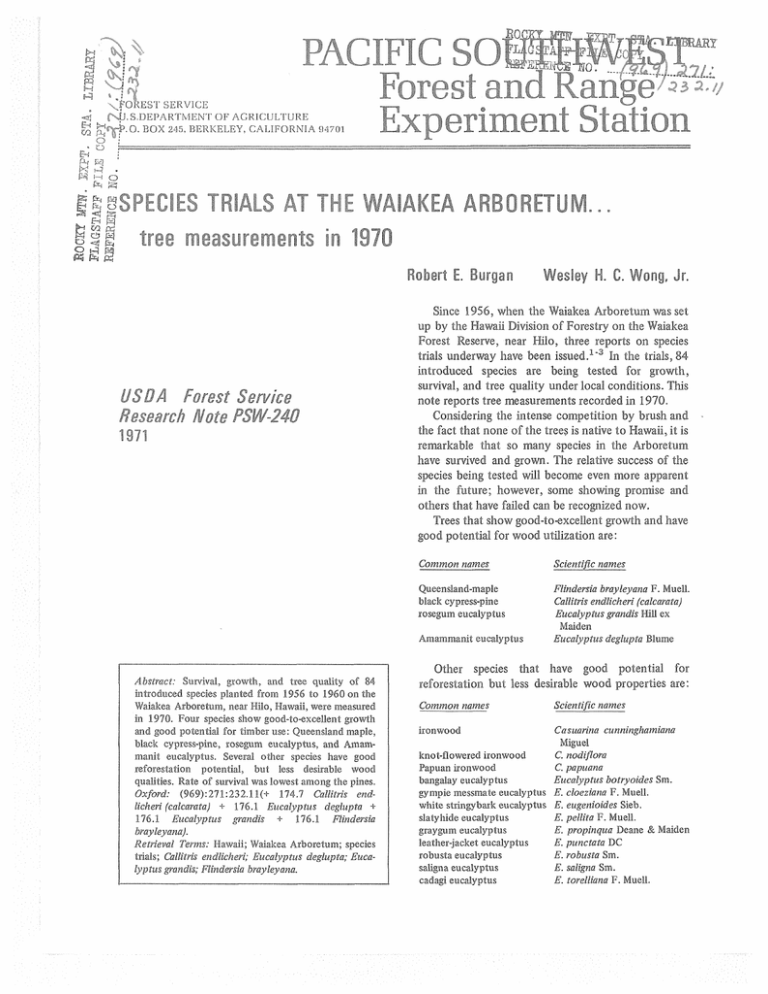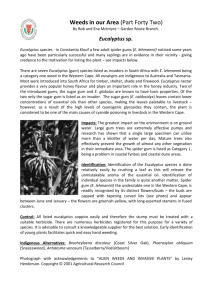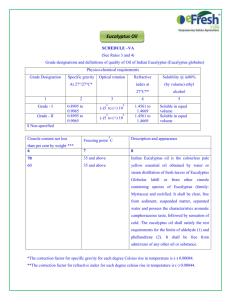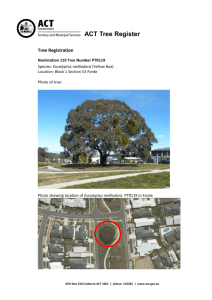' WA AT ALS
advertisement

'4 2p-p. $/a %CY!P. 2?; 223 S.DEPARTI\.IE:MT OF AGRICULTURE 0, EOX 245.BERKELEY. CALIFORNIA 94701 ALS AT THE tree measurements in WA AKEA ARBORETUM.. . Robert E. Burgan USDA Forest Service Research Note PSW-240 1971 Since 1956, when the Waiakea k"Bre"Em was set up by the HawaG Division of Forestry on the Waiakea Forest Reserve, near Hilo, three reports on species trials underway have been i~sued."~In the Mals, 84 introduced species are being tested for growh, surviml, and tree quality under local condi"cons. This note reports tree measurements recorded in 1970. Considering the intense competition by brush and the fact that none of the trees is native to HawG, it is remarkable that so many species in the Arboretum have survived and grown. The relative success of the species being tested will become even more apparent in the future; h o w w r , some showing prodse m d others that have faded can be recognized now. Trees that show good-toexcellent growh and have good poten"eal for wood utgization are: Common names Scientific names Queensland-maple black cypress-pine rosegum eucalyptus Flinders.sia brayleyana F.Muell. Callitvis endkicheri (calcarataj ficalyptus gandis f i l l ex Majiden Eucalyptus deglupl-a Blume Ammmanit eucdyptus Abstract: Sumival> growth, and tree qudity of 84 jiabtroduced species planted from 1956 t o I960 on the &Vaiakea Arboretum, near Hilo, Hawaii, were measured in 1970. Four species show good-to-excellent groWh m d good potential for timber use: Queensland maple, black cypress-pine, rosegum eucalypbs, and A m m manit eucalyptus. Sevexd other species have good reforestatio~~potential, but less deskable wood quabties. Rate of smival was lowest among the pines. Oxford: (969): 271 :232.1 I(+ 174.7 Callitvis endIicheri (calcauata) + 176.1 Eucalyptus deglupl-a -+ 176.1 Eucalyptus p n d i s + 176.1 Rindevsia Arboretum; species tus deglupta; Euca- Wesley H. C. Wong. Jr. Other species that have good potential for reforestation but less desirable wood properties are: Common names Scientific names Casuavina cunninghamiana Miguel G.nodiflova knot-nowered ironwood C. papuana Paguan konwood Eucalypl-us bokryoides Sm. bangalay eucalyptus gympie messmate eucalyptus K cloeziana F.Muell. white strjingybak eucalyptus E. eugenioides Sieb. E pellita F. Muell. slatyhide eucalyptus E. propinqua Deane & Maiden graygum eucalyptus leather-jacket eucalyptus E. puncfata DC E. vobusra Sm. robusta eucalyptus E. saligna Sm. sabgna eucalyptus E. torelliana IF. Muell. cadagi eucalyptus Species kmsidered hilures because of poor tree form are : Common names Scientific names jacaranda West Indies mahogany monkey-pod Jacaranda mimosifolia D. Don Swie fenia mahagoni Jacq . Rthecellobium saman (Jacq.) yellow-poinciana Spmish-cedar peppermint eucalyptus Peltophorum inerme Roxb . Cedrela odorat~L. Eucalyptus radiata Sied. ex Pinus caribaeo Pinus ellioffii 'att Callitris cupressiformis Pinus oocarpa Ben th. A r a u c o r i o heterophylla Fraxinus uhdei UNIT 3 "A" De teak Cedrela Tectona grandis L . The following 20 species have died since their origkd planting: Common names Scientific names cocoa Moreton-Bay-chestnut Theobroma cacao E. Castanospermum australe A. Swietenio mahugoni Jacaranda mim Khoya nyasico Pinus occidentalts Aroucorio hunsteini Pinus michoacana war. cornuta '2" Pelfophorum inerme "B" Pinus echinala Pinus sinensis war. yunnanensis Cunn. Pinus michoacana var, cornufa 'B': Eucalyptus bicolor A. Cunn. ex. Hook silverleaf eucalyptus -- Cuban bast .' Sydney acacia drooping cypress-pine sugar-gum eucalyptus yellowbox eucalyptus shinhg eucalyptus Mexican white pine Canary-Island pine shortleaf pine spruce pine Michoacana pine eggcone pine cluster pine Yunnan pine E. pulverulenta Sims. E. species (unidentified) Hibiscus elatus Sw. Acacia longifolia Willd. Callitris rhomboidea (cupressiformis) Eucalyptus cladocalyx F. Muell. E. melliodora A. Cunn. ex. Schau. E. nitens Maiden Binus ayacahuite Ehrenb. P. canariensis C. Smith. P. echinata Mill. P. glabra Walt. P. michoacana var. cornuta P. oocarpa Schiede. P. pinaster Soland. P. sinensis var. yunnanensis Shaw. P. echinata taeda X wind Data recorded in 1970 on survival, average height of five tallest trees, range in height, diamter at breast height, stand basal area per acre, average tree vigor, average tree quality, and sample size have been arized in tables. These tables are avalilable upon rcequest to the Director, Pacific Southwest Forest and Range Experiment Station, P. 8.Box 245, Berkeley, Gdifornia 94701;or to the Institute of Pacific Islands Forest@, Pacific Southwest Forest and Range Experiment Station, 530 South Hotel Street, Honolulu, Hawaii 96813. A map of the Waiakea hboreturn is also available. odorata 'B" Pinus ayacahuite Acacia saligna Acacia sophora Euc. melliodora Pithecellobiurn s a m a n Toona ciliafa war. auslrolis Pinus coribaea Pinus taeda fh"L\ Casuarino oligodon -------/ Pinus coriboea Casuarina popuana Euc. robertson Pinus echinata Pinus caribaea Pinus insularis Euc. diversicolor Pinus ellioffii Euc. eugenioides T o o n a c i l i a fo var, a u s t r a l i s '2" Figure l - R e Wakzkea Arboretum consists offour units on the Waiakea Forest Reserve, 6 miles south of Hilo, Hawii. Unit I was plankd in 1956; Unit 2 in 1957;. Unit 3 in 1959; and Unit 4 in 1960. maZs o f 8 4 introduced species are u n d e w ~ y . THE WAIAKEA ARBOWTUM The Waiakea kboretum consis"c of four unib. Fourken species were planted in Unit 1 in 1956. The remaining of the 84 species being tested were planted in Unit 2 (19571, Unit 3 (19591, and Unit 4 (1960) (fig. I). The Arboremum is about 6 ~ l e south s of Hilo, at 800 feet elevation. h n u a l precipitation averages about 200 inches and is &stri"oted quite evenly throughout the year. The temperature averages 70°F. The Arboretum has a well-drained, thin, extremely stony organic sod. In about 75 percent of the Arboretum, this sod overlies fragrmental volcanic aa and is of the Papai series. In the other 25 percent, the soil overlies volcanic pahoehoe rock and is of the Keaukaha series. Soil depths range from no soil on the pahoehoe to 40 inches in some of the aa flows. Ferns and shrubs p r e d o ~ n a t eon the aa where the planted trees have not formed a closed canopy. Each planting is an identifiable group of trees, all of the same species. The layout of individual plantings which range in size from 3 to 600 trees, varies from single rows to blocks. Each unit is composed of an aggregak of plantings. All plantings in the kboretum have been subjected to severe coqetition, primarily from malabar melastome (lVdelastom mlabal-hvicum), h e r i c a n pluchea (Pluchea odorata), melochia (Melochia hdica), oi (Stachytayhe ta jamicensis), mamaki (Pipturus albl'dus), t r u q e t tree (Cecropia peltat@),and neneleau (Rhus javanica). The trees sarnpled in Units 1 and 2 in 1962l were remeasured in 1970. All trees were measured in plantings of 30 or fewer trees; in larger plantings, a maximm of 30 trees were sampled except that in Unit 1, we sampled 30 trees from both the best and poorest portions of Norfolk-Island-pine and monkeypod plantings to glustrate the wide differences in growth in a single planting. In the Australian toon planting and plm"cng "K' of tropical ash, the smples were from pemanent 1/ I 0-acre circular growh plots that included more than 30 trees each. All trees in Unit 3 were measured in 1970, w,rhereas in 1964 a mximum of 30 trees per planting were ~ a m g l e d .In ~ Unit 4, plantings in excess of 30 trees were only sanzpled in 1970, whereas all the trees were measured in 1 9 6 5 . ~ Tree heights were measured to the nearest foot for the one shortest and five tallest trees sampled. Diameters were measured to the nearest 0.1 inch for all trees 0.5 inch d.b.h. or larger. The vigor of measured trees within each planting was classed as high, medium, or low on the basis of tree height, amount and color of foEage, evidence of dieback, and crown size. And the average vigor-class was computed for each planting. Stand basal area per acre was calculated from the (9.b.h. measurements for all plantings in wkch at least 30 trees were measured. Tree qudity was d e t e r ~ n e dfor each tree in a planting and the average quality assigned to each pl;m"cng accordkg to these rules: Class 1 Criteria: Existing or poten- 32 + feet tial sawlog length Less than 4 Sweep or crook inches in butt log None Defects (seams, rot, splits, etc.) Lean None Forking Only above 32 ft. High At least 8 ft. long in 3rd best face of butt log Vigor Clear panel (hardwoods only 1 Class 2 4 to 8 in. Less than 5 0 percent volume loss in butt log Less than 8 degrees Not below 12 ft. High to medium - Survival in each planting was based on the sample taken. CONDITION OF PfLmTmGS IN 1970 Survival of most plantings in Unit 1 is equal to or only slightly below that reported by &chrnond1 in 1963. We found two exceptions: jacaranda (hcaranda mimosaefolia) and yellow poinciana (Peltophomm inerme), both of which tended to bend over as height increased. The two species now show much reduced survival. Monkey-pod (Pithecellobiurn s a m n ) and West Indian mahogany (Swietenia rnahagoni) also had a significantly lower survival rate than in 1962. Apparently neither species could compete with the melastoma and melochia; most of the trees are now completely overtopped. 'bVith weeding, both species would probably have had better suwival and growth rates. Tropical ash (Daxinus uhdei) and Australian toon (Toona ciliata var. australis) are two species only planted for reforestation in Hawaii. Since 1962, the tropical ash has nearly doubled in height, and the average stand d.b.h. has increased from 3.5 inches to 5.6 inches. Although the ash shows good vigor, many trees were forked or excessively branched. The Australian toon has increased its average plmtings have died since 1962, all of which were in very poor condition at that lime. We tallied 53 pliantirzgs with live trees in 1970. Semral species, primarily eucalyptus, have shown remarkaule growh since 1962 (t~bEe I). Saligna eucalyptus (E* salimte), rosegum eucalyptus (E. g a ~ d i s ) ,and h a anit eucalyptus (E.deglupta) show good potential for reforesbtion, as they grow fast enough to require little brush control (fig. 2). Planted at a 10- by 10-foot spacing, these species have good form class and few persistent branches. Wood of h a m m a n i t (Kamarere) eucalyptus has the lowst density among the eucalypts being tested (I"abEe J ) . ~ ~ ~ &amter only 1.5 inches since 1962, and has shown virtually no heii&$ gromh. The tops of many trees are be&nnkg to die back. The most successful species in U n i t l has been Caribbean pine (Pifizls caribaea). Its average (4.b.h. has increased from 6.5 inches in 1962 to 14.4 inches in 1970. In 1962, the trees ranged in height from 30 to 35 feet they now range from 72 "c 885 feet. .All Unit 4. plantings FNhich had live trees in 196% still had some live trees in 1970. Unit 2-58 Planting In 1962, only one plan"cng had died, al"cough two others had less than 10 percent suwival. Four Table 1-Survival, growth, and average free quality of selected species in Unit 2, Waiakea Aboretum, Hilo, Hawaii, 1 9 6 2 ~and 2970 -Pevcen t Black cypress-pine (Callitris endliched(ca1caraLa)) Knot-flowered ironwood (Casua~inanodiflora) Gympie messmate eucalyptus (Eucalyptus cloeziana) Amammanit eucalyptus (Eucalyptus deglupta 'A') Amammani"cucalyp"cs (Eucalyptus deglupta 'B') M i t e stringybark eucalyptus (Eucalyptus eugenioides 'A? W t e stringybark eucalyptus (Eucalyptus eugenioides %') Rosegum eucalyptus (Eucalyptus grandis 'A') Rosegum eucalyptus (Eucalyptus grandis 'B') Grcaywm eucalyptus (Eucalyptus propinqua) Peppermint eucalyptus (Eucalyptus radiata) Salipa eucalyptus (Eucalyptus saligna ' A ' ~ ) Saligna eucalyptus (Eucalyplus saligna 'B y4) meensland-maple (Flindersia brayleyana 'Ay) Queensland-maple (Flindersia brayleyana 'B ') -Feet- 100 100 10-20 32-54 1.5 6.8 2 53 53 15-45 21-86 3.0 9.2 2 75 75 15-35 39-83 5.5 11.3 2 100 100 15-50 41-90 4.0 6.2 1 100 100 1040 15-70 3.5 5.4 1 370 75 10-25 34-84 1.5 8.2 2 74 57 5-40 24-79 2.5 8.8 2 97 97 5-40 43-110 2.5 10.0 2 92 92 15-60 27-132 4.0 8.7 1 92 67 5-45 22-95 2.0 8.1 1 77 63 10-45 34-88 3.5 10.0 3 100 77 10-45 8-90 3.0 7.2 2 98 83 10-60 29-109 4,5 8.8 2 89 57 <5-25 3-81 1.0 5.5 1 83 80 5-35 48-80 3.0 8.5 1 ' ~ r e equality data not available for 1962. ' ~ u a l i t y class designation: 1 = desirable; 2 = acceptable; 3 = cull. 3~ tree thought to be dead in 1962 subsequently sprouted. "'A' is Barrett's; 'Byis not Barre"cL's. -Inches- Figure 2 -Trees in this 13year-old rosep m eumluptus p l a n ~ n gin the Waiakea Arboretum mnged from 2 to 13.7 ia ekes d.b.h. me five f~lle%L trees averaged I22 feet in height. Of the species planted, only four pines-dash pine, eggcone pine, Phaippke pine, and jelecoke pine-have grown more than 3 inches in diameter during the past 5 years, and have m h t a h e d their suwival rate. Unit 4 has two rxliinor drainage channels. MortaJity was hi&er in these drainage channels than in diately adjacent areas. Both plantings of Queeflsland mple-an hportant reforestation tree-are s h o ~ n ggood growh. Survival on one plot was s o m e h a t low, but the remaink g trees show high vigor. Ironwood and knot-flowered ironwood seem to be well adapted to the site. Mthough their value as a timber species is low, they appear to be desirable for recreation areas "rpcause they form a stand having an open understory. The trees in h i t 2 were planted at 10-foot hkrvals and were 13 years old at the t h e of .the 1970 measurements. The faster growing species have not yet shown any evidence of stagnation. Of the 27 planthgs in Unit 3,13 have died and 10 others have survival rates of less than 25 percent. Except for one small planting (six trees) of Caribbean pine (Pinus cakbaea) all pines have essentially faded . The araucaria, Queens'and-maple9 Caribbean pine, shortleaf pine, eggcone pine, cluster pine, and 'oblo"~~ine~lantingsarere~licatedintheother units of the kboretum. Some of'khe species better in the other units than they did in Unit 3. Acknowledperzts: We are grateful for the technical m d field assistance provided by George T. Hashimoto md Efilio D. Acia, Jr., Forest Sewice, U.S. Department of Agriculture; Edwin Q.I?. Petteys, Hawaii Division of Forestry; and field crews made available by Libert K. Landgraf, Hawaii Division of Forestry. NOTES ' ~ c h m o n d , George B. Species trials at the Waiakea Arboretum, Hilo, fiwaii. U.S. Forest Sen. Res. Paper PSW-4, Pacific SW. Forest 8& Range Exp. S h . , Berkeley, Calif. 21 p., illus. 1963. 2 ~ q e n ~ r Stanley , B., and George B. Richmond. Five year measurements of Unit 3, Waiakea Arboretum, Hakvaii. U.S. Forest Sew. Res. Note PSW-43, Pacific SW. Forest b(r Range Exp. Sta., Berkeley, Calif. 5 p., illus. 1945. ' ~ ~ e n k e rStanley , ]B. Survival and five-year gowth in Unit 4,Waiakea Arboretum, Hawaii. U.S. Forest Sew. Res. Note PSW--88, Pacific SW. Forest & Range Exp. Sta., Berkeley, Calif, illus. 1965. '~olza, E., and H. H. Mloot. 'Fhe mechanical propertks of 811 New Guinea timbers CSI.R.0. Forest Prod. Div.. Tech. P,pep 4 1 , p. ~ 1966. "ingston,R.S.T.,andC.J.E.fisdon.Shrinkageand density of Australian and other S. W. PaciJic woods, CSI.KZ.0. Forest Prod. Div., Tech. Paper 13,65 p. 1961. The Authors U.S. Forest Service research in Hawaii is conducted in cooperation with Evision of Forestsr~r~ H m a i Depa&men$of Land a d Nalwal Resources ROBERT E. BURGm joined the staff of khe Stal-ion's Institute of Pacific Islands Forestry, Honolulu, Hawaii, in 1969. Me received bachelor's (1963) and master's (1966) degees in foresky at the Unkersity of Montana. WSkEY H. C. WONG,Jr,, has been with the Hawaii Division of Forestry since 1944, when he was gaduated from Oregon State University with a bachelor's degree in forestrgr. GPO 981-180


